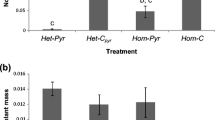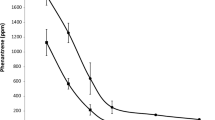Abstract
Background and aims
Biodegradation of polycyclic aromatic hydrocarbons (PAHs) is accelerated in the presence of plants, due to the stimulation of rhizosphere microbes by plant exudates (nonspecific enhancement). However, plants may also recruit specific microbial groups in response to PAH stress (specific enhancement). In this study, plant effects on the development of rhizosphere microbial communities in heterogeneously contaminated soils were assessed for three grasses (ryegrass, red fescue and Yorkshire fog) and four legumes (white clover, chickpea, subterranean clover and red lentil).
Methods
Plants were cultivated using a split-root model with their roots divided between two independent pots containing either uncontaminated soil or PAH-contaminated soil (pyrene or phenanthrene). Microbial community development in the two halves of the rhizosphere was assessed by T-RFLP (bacterial and fungal community) or DGGE (bacterial community), and by 16S rRNA gene tag-pyrosequencing.
Results
In legume rhizospheres, the microbial community structure in the uncontaminated part of the split-root model was significantly influenced by the presence of PAH-contamination in the other part of the root system (indirect effect), but this effect was not seen for grasses. In the contaminated rhizospheres, Verrucomicrobia and Actinobacteria showed increased populations, and there was a dramatic increase in Denitratisoma numbers, suggesting that this genus may be important in rhizoremediation processes.
Conclusion
Our results show that Trifolium and other legumes respond to PAH-contamination stress in a systemic manner, to influence the microbial diversity in their rhizospheres.




Similar content being viewed by others
References
Acosta-Martinez V, Dowd S, Sun Y, Allen V (2008) Tag-encoded pyrosequencing analysis of bacterial diversity in a single soil type as affected by management and land use. Soil Biol Biochem 40:2762–2770
Anderson TA, Guthrie EA, Walton BT (1993) Bioremediation in the rhizosphere. Environ Sci Technol 27:2630–2636
Binet P, Portal JM, Leyval C (2000) Dissipation of 3-6-ring polycyclic aromatic hydrocarbons in the rhizosphere of ryegrass. Soil Biol Biochem 32:2011–2017
Cébron A, Beguiristain T, Faure P, Norini MP, Masfaraud JF, Leyval C (2009) Influence of vegetation on the in situ bacterial community and polycyclic aromatic hydrocarbon (PAH) degraders in aged PAH-contaminated or thermal-desorption-treated soil. Appl Environ Microbiol 75:6322–6330
Cébron A, Louvel B, Faure P, France-Lanord C, Chen Y, Murrell JC, Leyval C (2011) Root exudates modify bacterial diversity of phenanthrene degraders in PAH-polluted soil but not phenanthrene degradation rates. Environ Microbiol 13:722–736
Chiapusio G, Pujol S, Toussaint ML, Badot PM, Binet P (2007) Phenanthrene toxicity and dissipation in rhizosphere of grassland plants (Lolium perenne L. and Trifolium pratense L.) in three spiked soils. Plant Soil 294:103–112
Child R, Miller CD, Liang Y, Narasimham G, Chatterton J, Harrison P, Sims RC, Britt D, Anderson AJ (2007) Polycyclic aromatic hydrocarbon-degrading Mycobacterium isolates: their association with plant roots. Appl Microbiol Biotechnol 75:655–663
Corgie SC, Joner EJ, Leyval C (2003) Rhizospheric degradation of phenanthrene is a function of proximity to roots. Plant Soil 257:143–150
Cunliffe M, Kertesz MA (2006) Effect of Sphingobium yanoikuyae B1 inoculation on bacterial community dynamics and polycyclic aromatic hydrocarbon degradation in aged and freshly PAH-contaminated soils. Environ Pollut 144:228–237
Fahrbach M, Kuever J, Meinke R, Kämpfer P, Hollender J (2006) Denitratisoma oestradiolicum gen. nov., sp nov., a 17 β-oestradiol-degrading, denitrifying betaproteobacterium. Int J Syst Evol Microbiol 56:1547–1552
Gao YZ, Shen Q, Ling WT, Ren LL (2008) Uptake of polycyclic aromatic hydrocarbons by Trifolium pretense L. from water in the presence of a nonionic surfactant. Chemosphere 72:636–643
Habe H, Omori T (2003) Genetics of polycyclic aromatic hydrocarbon metabolism in diverse aerobic bacteria. Biosci Biotechnol Biochem 67:225–243
Haritash AK, Kaushik CP (2009) Biodegradation aspects of Polycyclic Aromatic Hydrocarbons (PAHs): A review. J Hazard Mater 169:1–15
Johnsen AR, Wick LY, Harms H (2005) Principles of microbial PAH-degradation in soil. Environ Pollut 133:71–84
Kamath R, Schnoor JL, Alvarez PJJ (2004) Effect of root-derived substrates on the expression of nah-lux genes in Pseudomonas fluorescens HK44: Implications for PAH biodegradation in the rhizosphere. Environ Sci Technol 38:1740–1745
Kim YB, Park KY, Chung Y, Oh KC, Buchanan BB (2004) Phytoremediation of anthracene contaminated soils by different plant species. J Plant Biol 47:174–178
Kosslak RM, Bohlool BB (1984) Suppression of nodule development of one side of a split-root system of soybeans caused by prior inoculation of the other side. Plant Physiol 75:125–130
Kuiper I, Lagendijk EL, Bloemberg GV, Lugtenberg BJJ (2004) Rhizoremediation: a beneficial plant-microbe interaction. Mol Plant Microbe Interact 17:6–15
Langer I, Syafruddin S, Steinkellner S, Puschenreiter M, Wenzel WW (2010) Plant growth and root morphology of Phaseolus vulgaris L. grown in a split-root system is affected by heterogeneity of crude oil pollution and mycorrhizal colonization. Plant Soil 332:339–355
Lee SH, Lee WS, Lee CH, Kim JG (2008) Degradation of phenanthrene and pyrene in rhizosphere of grasses and legumes. J Hazard Mater 153:892–898
Li Y, Yediler A, Ou ZQ, Conrad I, Kettrup A (2001) Effects of a non-ionic surfactant (Tween-80) on the mineralization, metabolism and uptake of phenanthrene in wheat-solution-lava microcosm. Chemosphere 45:67–75
Matilla MA, Ramos JL, Bakker P, Doornbos R, Badri DV, Vivanco JM, Ramos-Gonzalez MI (2010) Pseudomonas putida KT2440 causes induced systemic resistance and changes in Arabidopsis root exudation. Environ Microbiol Rep 2:381–388
Meharg AA, Killham K (1995) Loss of exudates from the roots of perennial ryegrass inoculated with a range of microorganisms. Plant Soil 170:345–349
Muratova A, Golubev S, Wittenmayer L, Dmitrieva T, Bondarenkova A, Hirche F, Merbach W, Turkovskaya O (2009a) Effect of the polycyclic aromatic hydrocarbon phenanthrene on root exudation of Sorghum bicolor (L.) Moench. Environ Exp Bot 66:514–521
Muratova AY, Golubev SN, Merbach W, Turkovskaya OV (2009b) Biochemical and physiological peculiarities of the interactions between Sinorhizobium meliloti and Sorghum bicolor in the presence of phenanthrene. Microbiology 78:308–314
Muyzer G, Dewaal EC, Uitterlinden AG (1993) Profiling of complex microbial-populations by denaturing gradient gel electrophoresis analysis of polymerase chain reaction-amplified genes coding for 16S ribosomal RNA. Appl Environ Microbiol 59:695–700
Rotaru AE, Probian C, Wilkes H, Harder J (2010) Highly enriched Betaproteobacteria growing anaerobically with p-xylene and nitrate. FEMS Microbiol Ecol 71:460–468
Salt DE, Smith RD, Raskin I (1998) Phytoremediation. Ann Rev Plant Physiol Plant Mol Biol 49:643–668
Sangwan P, Kovac S, Davis KER, Sait M, Janssen PH (2005) Detection and cultivation of soil Verrucomicrobia. Appl Environ Microbiol 71:8402–8410
Schmidtke K (2005) A model to predict the accuracy of measurements of legume N rhizodeposition using a split-root technique. Soil Biol Biochem 37:829–836
Schneider K, Roller M, Kalberlah F, Schuhmacher-Wolz U (2002) Cancer risk assessment for oral exposure to PAH mixtures. J Appl Toxicol 22:73–83
Shaw LJ, Burns RG (2004) Enhanced mineralization of [U-14 C]2,4-dichlorophenoxyacetic acid in soil from the rhizosphere of Trifolium pratense. Appl Environ Microbiol 70:4766–4774
Shaw LJ, Burns RG (2005a) Rhizodeposition and the enhanced mineralization of 2,4-dichlorophenoxyacetic acid in soil from the Trifolium pratense rhizosphere. Environ Microbiol 7:191–202
Shaw LJ, Burns RG (2005b) Rhizodeposits of Trifolium pratense and Lolium perenne: their comparative effects on 2,4-D mineralization in two contrasting soils. Soil Biol Biochem 37:995–1002
Siciliano SD, Germida JJ (1997) Bacterial inoculants of forage grasses that enhance degradation of 2-chlorobenzoic acid in soil. Environ Toxicol Chem 16:1098–1104
Siciliano SD, Germida JJ (1998) Mechanisms of phytoremediation: biochemical and ecological interactions between plants and bacteria. Environ Rev 6:65–79
Siciliano SD, Germida JJ, Banks K, Greer CW (2003) Changes in microbial community composition and function during a polyaromatic hydrocarbon phytoremediation field trial. Appl Environ Microbiol 69:483–489
Singh BK, Nunan N, Ridgway KP, McNicol J, Peter J, Young W, Daniell TJ, Prosser JI, Millard P (2008) Relationship between assemblages of mycorrhizal fungi and bacteria on grass roots. Environ Microbiol 10:534–541
Sipilä TP, Keskinen A-K, Åkerman M-L, Fortelius C, Haahtela K, Yrjälä K (2008) High aromatic ring-cleavage diversity in birch rhizosphere: PAH treatment-specific changes of I.E.3 group extradiol dioxygenases and 16S rRNA bacterial communities in soil. ISME J 2:968–981
Smith CJ, Danilowicz BS, Clear AK, Costello FJ, Wilson B, Meijer WG (2005) T-Align, a web-based tool for comparison of multiple terminal restriction fragment length polymorphism profiles. FEMS Microbiol Ecol 54:375–380
Walton BT, Hoylman AM, Perez MM, Anderson TA, Johnson TR, Guthrie EA, Christman RF (1994) Rhizosphere microbial communities as a plant defense against toxic-substances in soils. In: Anderson TA, Coats JR (eds) Bioremediation through rhizosphere technology. American Chemical Society, Washington, D.C, pp 82–92
Wenzel WW (2009) Rhizosphere processes and management in plant-assisted bioremediation (phytoremediation) of soils. Plant Soil 321:385–408
White TJ, Bruns T, Lee S, Taylor J (1990) Amplification and direct sequencing of fungal ribosomal RNA genes for phylogenetics. In: Innis MA, Gelfand DH, Sninsky JJ, White TJ (eds) PCR protocols: a guide to methods and applications. Academic, San Diego, pp 315–322
Yrjälä K, Keskinen AK, Åkerman ML, Fortelius C, Sipilä TP (2010) The rhizosphere and PAH amendment mediate impacts on functional and structural bacterial diversity in sandy peat soil. Environ Pollut 158:1680–1688
Acknowledgements
This work was supported by the Heiwa Nakajima Foundation, the University of Manchester, Faculty of Life Sciences, and the University of Sydney, Faculty of Agriculture, Food and Natural Resources. We thank B. Singh for assistance with soil characterization data.
Author information
Authors and Affiliations
Corresponding author
Additional information
Responsible Editor: Bernard Glick.
Rights and permissions
About this article
Cite this article
Kawasaki, A., Watson, E.R. & Kertesz, M.A. Indirect effects of polycyclic aromatic hydrocarbon contamination on microbial communities in legume and grass rhizospheres. Plant Soil 358, 169–182 (2012). https://doi.org/10.1007/s11104-011-1089-z
Received:
Accepted:
Published:
Issue Date:
DOI: https://doi.org/10.1007/s11104-011-1089-z




